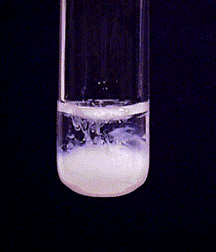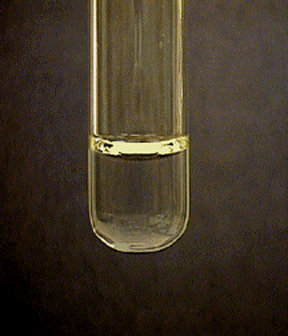Characteristic Reactions of Lead Ions (Pb²⁺)
- Page ID
- 97271
\( \newcommand{\vecs}[1]{\overset { \scriptstyle \rightharpoonup} {\mathbf{#1}} } \)
\( \newcommand{\vecd}[1]{\overset{-\!-\!\rightharpoonup}{\vphantom{a}\smash {#1}}} \)
\( \newcommand{\id}{\mathrm{id}}\) \( \newcommand{\Span}{\mathrm{span}}\)
( \newcommand{\kernel}{\mathrm{null}\,}\) \( \newcommand{\range}{\mathrm{range}\,}\)
\( \newcommand{\RealPart}{\mathrm{Re}}\) \( \newcommand{\ImaginaryPart}{\mathrm{Im}}\)
\( \newcommand{\Argument}{\mathrm{Arg}}\) \( \newcommand{\norm}[1]{\| #1 \|}\)
\( \newcommand{\inner}[2]{\langle #1, #2 \rangle}\)
\( \newcommand{\Span}{\mathrm{span}}\)
\( \newcommand{\id}{\mathrm{id}}\)
\( \newcommand{\Span}{\mathrm{span}}\)
\( \newcommand{\kernel}{\mathrm{null}\,}\)
\( \newcommand{\range}{\mathrm{range}\,}\)
\( \newcommand{\RealPart}{\mathrm{Re}}\)
\( \newcommand{\ImaginaryPart}{\mathrm{Im}}\)
\( \newcommand{\Argument}{\mathrm{Arg}}\)
\( \newcommand{\norm}[1]{\| #1 \|}\)
\( \newcommand{\inner}[2]{\langle #1, #2 \rangle}\)
\( \newcommand{\Span}{\mathrm{span}}\) \( \newcommand{\AA}{\unicode[.8,0]{x212B}}\)
\( \newcommand{\vectorA}[1]{\vec{#1}} % arrow\)
\( \newcommand{\vectorAt}[1]{\vec{\text{#1}}} % arrow\)
\( \newcommand{\vectorB}[1]{\overset { \scriptstyle \rightharpoonup} {\mathbf{#1}} } \)
\( \newcommand{\vectorC}[1]{\textbf{#1}} \)
\( \newcommand{\vectorD}[1]{\overrightarrow{#1}} \)
\( \newcommand{\vectorDt}[1]{\overrightarrow{\text{#1}}} \)
\( \newcommand{\vectE}[1]{\overset{-\!-\!\rightharpoonup}{\vphantom{a}\smash{\mathbf {#1}}}} \)
\( \newcommand{\vecs}[1]{\overset { \scriptstyle \rightharpoonup} {\mathbf{#1}} } \)
\( \newcommand{\vecd}[1]{\overset{-\!-\!\rightharpoonup}{\vphantom{a}\smash {#1}}} \)
\(\newcommand{\avec}{\mathbf a}\) \(\newcommand{\bvec}{\mathbf b}\) \(\newcommand{\cvec}{\mathbf c}\) \(\newcommand{\dvec}{\mathbf d}\) \(\newcommand{\dtil}{\widetilde{\mathbf d}}\) \(\newcommand{\evec}{\mathbf e}\) \(\newcommand{\fvec}{\mathbf f}\) \(\newcommand{\nvec}{\mathbf n}\) \(\newcommand{\pvec}{\mathbf p}\) \(\newcommand{\qvec}{\mathbf q}\) \(\newcommand{\svec}{\mathbf s}\) \(\newcommand{\tvec}{\mathbf t}\) \(\newcommand{\uvec}{\mathbf u}\) \(\newcommand{\vvec}{\mathbf v}\) \(\newcommand{\wvec}{\mathbf w}\) \(\newcommand{\xvec}{\mathbf x}\) \(\newcommand{\yvec}{\mathbf y}\) \(\newcommand{\zvec}{\mathbf z}\) \(\newcommand{\rvec}{\mathbf r}\) \(\newcommand{\mvec}{\mathbf m}\) \(\newcommand{\zerovec}{\mathbf 0}\) \(\newcommand{\onevec}{\mathbf 1}\) \(\newcommand{\real}{\mathbb R}\) \(\newcommand{\twovec}[2]{\left[\begin{array}{r}#1 \\ #2 \end{array}\right]}\) \(\newcommand{\ctwovec}[2]{\left[\begin{array}{c}#1 \\ #2 \end{array}\right]}\) \(\newcommand{\threevec}[3]{\left[\begin{array}{r}#1 \\ #2 \\ #3 \end{array}\right]}\) \(\newcommand{\cthreevec}[3]{\left[\begin{array}{c}#1 \\ #2 \\ #3 \end{array}\right]}\) \(\newcommand{\fourvec}[4]{\left[\begin{array}{r}#1 \\ #2 \\ #3 \\ #4 \end{array}\right]}\) \(\newcommand{\cfourvec}[4]{\left[\begin{array}{c}#1 \\ #2 \\ #3 \\ #4 \end{array}\right]}\) \(\newcommand{\fivevec}[5]{\left[\begin{array}{r}#1 \\ #2 \\ #3 \\ #4 \\ #5 \\ \end{array}\right]}\) \(\newcommand{\cfivevec}[5]{\left[\begin{array}{c}#1 \\ #2 \\ #3 \\ #4 \\ #5 \\ \end{array}\right]}\) \(\newcommand{\mattwo}[4]{\left[\begin{array}{rr}#1 \amp #2 \\ #3 \amp #4 \\ \end{array}\right]}\) \(\newcommand{\laspan}[1]{\text{Span}\{#1\}}\) \(\newcommand{\bcal}{\cal B}\) \(\newcommand{\ccal}{\cal C}\) \(\newcommand{\scal}{\cal S}\) \(\newcommand{\wcal}{\cal W}\) \(\newcommand{\ecal}{\cal E}\) \(\newcommand{\coords}[2]{\left\{#1\right\}_{#2}}\) \(\newcommand{\gray}[1]{\color{gray}{#1}}\) \(\newcommand{\lgray}[1]{\color{lightgray}{#1}}\) \(\newcommand{\rank}{\operatorname{rank}}\) \(\newcommand{\row}{\text{Row}}\) \(\newcommand{\col}{\text{Col}}\) \(\renewcommand{\row}{\text{Row}}\) \(\newcommand{\nul}{\text{Nul}}\) \(\newcommand{\var}{\text{Var}}\) \(\newcommand{\corr}{\text{corr}}\) \(\newcommand{\len}[1]{\left|#1\right|}\) \(\newcommand{\bbar}{\overline{\bvec}}\) \(\newcommand{\bhat}{\widehat{\bvec}}\) \(\newcommand{\bperp}{\bvec^\perp}\) \(\newcommand{\xhat}{\widehat{\xvec}}\) \(\newcommand{\vhat}{\widehat{\vvec}}\) \(\newcommand{\uhat}{\widehat{\uvec}}\) \(\newcommand{\what}{\widehat{\wvec}}\) \(\newcommand{\Sighat}{\widehat{\Sigma}}\) \(\newcommand{\lt}{<}\) \(\newcommand{\gt}{>}\) \(\newcommand{\amp}{&}\) \(\definecolor{fillinmathshade}{gray}{0.9}\)- Most common oxidation states: +2, +4
- M.P. 328º
- B.P. 1750º
- Density 11.35 g/cm3
- Characteristics: Lead is a soft metal having little tensile strength, and it is the densest of the common metals excepting gold and mercury. It has a metallic luster when freshly cut but quickly acquires a dull color when exposed to moist air.
- Characteristic reactions of \(\ce{Pb^{2+}}\): The +2 oxidation state is the more stable state.
Chloride Ion
Soluble chlorides, such as hydrochloric acid, precipitate white lead chloride from \(\ce{Pb^{2+}}\) solutions, when the solutions are not too dilute:
\[\ce{Pb^{2+}(aq) + 2Cl^{-}(aq)<=> PbCl2(s) } \nonumber \]

Lead chloride is a slightly soluble salt, with a solubility of 10 g/L at 20º. The solubility of \(\ce{PbCl2}\) increases very rapidly as the temperature rises. At 100º it has a solubility of 33.5 g/L. However, \(\ce{PbCl2}\) precipitates very slowly, particularly when other ions that form insoluble chlorides are not present. The precipitation can be speeded up by vigorously rubbing the inside of the test tube with a stirring rod. Even then the precipitate may not form until 3 to 5 minutes after mixing the solutions. \(\ce{PbCl2}\) dissolves in excess chloride ion as a result of the formation of the tetrachloroplumbate(II) complex ion:
\[\ce{PbCl2(s) + 2Cl^{-}(aq)<=> [PbCl4]^{2-}(aq) } \nonumber \]

Sulfate Ion
Soluble sulfates, including dilute sulfuric acid, precipitate white lead sulfate, which is much less soluble than lead chloride:
\[\ce{Pb^{2+}(aq) + SO4^{2-}(aq)<=> PbSO4(s) } \nonumber \]

\(\ce{PbSO4}\) dissolves in concentrated solutions of hydroxide or acetate ions.
\[\ce{PbSO4(s) + 4OH^{-}(aq)<=> [Pb(OH)4]^{2-}(aq) + SO4^{2-}(aq) } \nonumber \]
\[\ce{PbSO4(s) + 2CH3CO2^{-}(aq)<=> Pb(CH3CO2)2(aq) + SO4^{2-}(aq) } \nonumber \]

The lead acetate, though only slightly dissociated, is soluble.
Aqueous Ammonia
Lead(II) ion reacts with aqueous ammonia to precipitate a white basic salt, \(\ce{Pb2O(NO3)2}\), rather than the expected lead(II) hydroxide:
\[\ce{Pb^{2+}(aq) + 2NH3(aq) + 3H2O(l) + 2NO3^{-}(aq)<=> Pb2O(NO3)2(s) + H2O(l) + 2NH4^{+}(aq) } \nonumber \]

The basic salt is insoluble in excess ammonia.
Sodium Hydroxide
Sodium hydroxide precipitates lead(II) hydroxide, which dissolve with excess hydroxide:
\[\ce{Pb^{2+}(aq) + 2OH^{-}(aq)<=> Pb(OH)2(s) } \nonumber \]

\[\ce{Pb(OH)2(s) + 2OH^{-}(aq)<=> [Pb(OH)4]^{2-}(aq) } \nonumber \]



